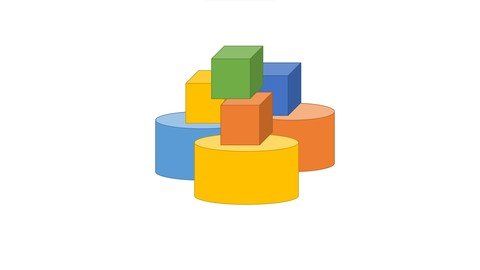
Free Download Data Vault Mastery
Published 7/2023
MP4 | Video: h264, 1280x720 | Audio: AAC, 44.1 KHz
Language: English | Size: 3.43 GB | Duration: 7h 0m
Modernizing Data Warehousing for Advanced
What you'll learn
Modernizing Data Warehousing for Advanced Analytics with the powerful methodology of Data Vault 2.0
Scalable Data Vault 2.0 data warehouse architecture
Data Vault 2.0 methodology in discussing project planning & execution
How to Modelling Data Vault 1.0 & 2.0
The real practical of Data Vault 2.0 with Loading Patterns, ETL Load, HashKey
How to design Dimensional Model
Master Data Management from architecture to implementation steps
Meta data management on each data layers and how to capture metadata
What is Multi-dimensional Database (OLAP CUBE)
Update Enterprise Data warehouse (DWH) Platform from IBM, AWS and Data Vault 2.0 technology landscape
Hands-On Lab with loading source to datavautl, to datamart and to OLAP CUBE by using SQL Server, SSIS, SSAS
Requirements
Basic Knowledge of Data Warehousing: Familiarity with data warehousing concepts, including the purpose and architecture of data warehouses, data modeling, and ETL processes, will be helpful.
Database Fundamentals: Understanding of fundamental database concepts, such as tables, relationships, and SQL queries, is beneficial.
Business Intelligence and Analytics: Some knowledge of business intelligence tools and analytics concepts can be advantageous for understanding the application of data vault methodology in advanced analytics.
Data Modeling: Familiarity with data modeling techniques, such as entity-relationship diagrams and dimensional modeling, can be beneficial for comprehending the concepts taught in the course.
Database Management Systems: Basic knowledge of database management systems (e.g., Oracle, SQL Server, etc.) is recommended, as data vault implementation may involve working with different databases.
Data Integration: Awareness of data integration processes and tools, such as ETL (Extract, Transform, Load), is helpful for understanding data vault load patterns.
Description
Course Overview
Overview
Section 1: Introduction
Lecture 1 Introduction
Lecture 2 Course Outline and Key Learning Outcomes
Lecture 3 Get the Matterials
Section 2: Data warehouse Introduction
Lecture 4 Enterprise data warehouse environment
Lecture 5 Introduction to Data Vault
Lecture 6 Data warehouse architecture
Section 3: Flexible & scalable data warehouse architecture
Lecture 7 Struggling of data warehouse with changes
Lecture 8 Data vault 2.0 architecture
Lecture 9 Business rules application
Lecture 10 Staging area layer
Lecture 11 Data warehouse layer
Lecture 12 Information mart layer
Lecture 13 Extension of data vault 2.0 architecture >> Metrics Vault
Lecture 14 Business Vault
Lecture 15 Operational Vault
Section 4: The data vault 2.0 methodology
Lecture 16 Project planning
Lecture 17 Project planning >> Roles & Duties
Lecture 18 Project planning >> Communication
Lecture 19 Project planning >> CMMI maturity model
Lecture 20 Project planning >> SCRUM
Lecture 21 Project planning >> Estimation of the project
Lecture 22 Project execution
Lecture 23 Project execution >> Implementation steps under agile - Scrum methodology
Section 5: The data vault modelling
Lecture 24 The data vault modelling
Lecture 25 Data vault 1.0 use case, requirement, database diagram & table structure
Lecture 26 Data vault 1.0 modelling
Lecture 27 Data vault 1.0 hub, link, satellite, ETL load
Lecture 28 Data vault 2.0 definition
Lecture 29 Data vault 2.0 application >> hub application
Lecture 30 Link application >> Link on Link
Lecture 31 Link application >> Same as Link
Lecture 32 Link application >> Hierarchical Link
Lecture 33 Link application >> Computed Aggregate Link
Lecture 34 Link application >> Exploration Link
Lecture 35 Satellite application >> Overloaded Satellites
Lecture 36 Satellite application >> Multi-active Satellites
Lecture 37 Satellite application >> Status tracking Satellites
Lecture 38 Satellite application >> Effectively Satellites
Lecture 39 Satellite application >> Computed Satellites
Lecture 40 Advanced data vault modeling >> Point-In-Time tables
Lecture 41 Advanced data vault modeling >> Bridge tables
Lecture 42 Data vault 2.0 flexibility
Section 6: The data vault implementation
Lecture 43 Data vault 2.0 introduction & use case implementation
Lecture 44 Data vault 2.0 load patterns >> hub, link, satellite, ETL load
Lecture 45 Data vault 2.0 load patterns >> hash key & parallel
Section 7: Dimensional modeling
Lecture 46 Dimensional modeling: star schemas, multi-dimension schemas, dimension design
Section 8: Master data management - MDM
Lecture 47 Master data management: MDM architecture & implementation steps
Section 9: Meta data management
Lecture 48 Meta data type
Lecture 49 Metadata capturing >> Source system
Lecture 50 Metadata capturing >> Staging
Lecture 51 Metadata capturing >> Metadata for loading hub entities
Lecture 52 Metadata capturing >> Metadata for loading link entities
Lecture 53 Metadata capturing >> Metadata for loading satellite entities on hubs
Lecture 54 Metadata capturing >> Metadata for loading satellite entities on links
Lecture 55 Metadata capturing >> Metadata for loading data vault to Datamart
Section 10: Multi-dimensional database (MOLAP cube)
Lecture 56 Multi-dimensional database
Section 11: Data warehouse platform
Lecture 57 Data warehouse - data lake platform updates: IBM & AWS data platform
Section 12: Hands-on practices
Lecture 58 SSIS load: source to Datavault, to Datamart, to OLAP cube
Section 13: Summary session
Lecture 59 Data Vault Mastery Modernizing Data Warehousing for Advanced Analytics
Data Warehouse Architects,Data Engineers,Business Intelligence (BI) Developers,Data Analysts,Data Scientists,Data Managers and Data Governance Professionals,IT Managers and Professionals,Data Modellers
Homepage
Recommend Download Link Hight Speed | Please Say Thanks Keep Topic Live
No Password - Links are Interchangeable






